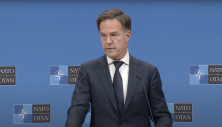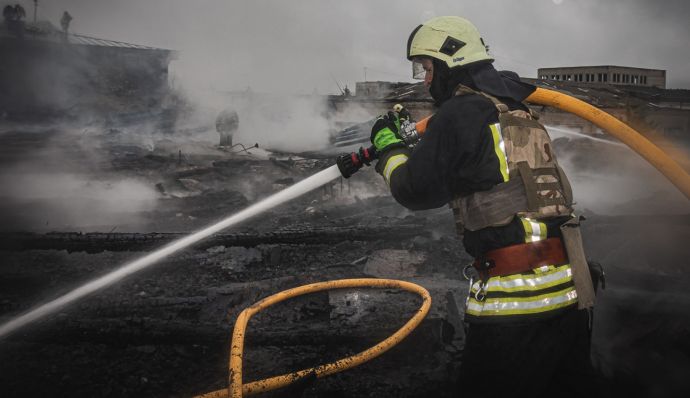Russia continues to violate the agreement on the so-called energy truce. This morning, April 1, the occupiers attacked an energy facility in Kherson, leaving 45,000 residents without electricity.
According to the head of the Kherson City Military Administration (CMA) Roman Mrochko, part of the Central and Korabelnyi districts of the city of Kherson are currently without electricity supply. Specialists are working on identifying and eliminating the consequences of network damage.
In addition, according to Mrochko, under the fire of enemy aviation, artillery, and drones, besides Kherson, were Antonivka, Komyshany, and Blahovishchenske. In particular, private and multi-story buildings, as well as a civilian car, were damaged.
According to the head of the Kherson CMA, three people were injured in a day, two of them seriously. Also, due to partial power outages in Kherson, electric transport was temporarily out of service.
Let us recall that this is not the first attack by Russian occupiers on energy facilities in Kherson. Russia had previously violated the agreement on the mutual cessation of strikes on energy facilities. Thus, as a result of shelling on the night of March 27, energy facilities in Kherson were damaged.
During a press conference in Paris after a meeting of leaders on supporting Ukraine and security in Europe, President Volodymyr Zelenskyy stated that Kyiv would prepare all evidence of Russia’s shelling of our facilities.
The President emphasized that Defense Minister Rustem Umerov received this order. He explained that this information would be prepared and transferred to the United States. Zelenskyy also noted that after this, Ukraine expects a reaction from the United States, as the American side had said it would respond to any violations.
Ukraine’s Foreign Minister Andrii Sybiha, during a joint press conference with his Lithuanian colleague Kęstutis Budrys, commenting on another terrorist act by the Russian occupiers, stated that after negotiations in Riyadh, one of the agreements with the United States was to stop strikes on energy infrastructure.
The minister emphasized that Russia continues to violate this agreement. There have already been damages to energy facilities in Kherson, Kharkiv, and in the Poltava region.
“And this morning, another Russian strike damaged an energy facility in Kherson, leaving 45,000 residents without electricity,” added the head of the MFA.
Let us recall that after a telephone conversation between U.S. President Donald Trump and Russian dictator Putin, the Kremlin announced Russia’s refusal to strike energy infrastructure facilities for 30 days. After this, Trump spoke with Zelenskyy, who stated that Ukraine had agreed to stop attacks on energy infrastructure provided that Russia also agreed.
It is worth noting that, according to the Main Intelligence Directorate of the Ministry of Defense of Ukraine (HUR MO), in 2023, Russian documents had clearly defined targets for attacks by drones, cruise, and ballistic missiles. Among the primary targets: energy infrastructure facilities and Ukraine’s gas transportation system.
According to HUR MO representative Skibitskyi, the Russians changed their approach to attacks, using a targeting tactic — careful planning of strikes for maximum effect. The enemy is trying to destroy critical infrastructure as much as possible.
“We have already seen attacks on thermal power plants. Especially powerful strikes were in the Kharkiv region, where the occupiers tried to leave people without heat. The gas transportation system and gas fields also suffer, as the Russians seek to deprive Ukraine of its own gas,” stated the representative of Ukrainian intelligence.
Currently, the Russian side is deliberately delaying the negotiation process, and the date they named for stopping attacks on energy infrastructure, March 18, is merely a sign that they supposedly dictate the rules of the negotiation process.
The point is that the statements of Kremlin representatives are merely an imitation of the negotiation process, not the process itself.
It is worth noting that the date for stopping attacks was set unilaterally by the Russian side. This date was not agreed upon by either the American or Ukrainian sides. In fact, Russia retains the right and creates the conditions to unilaterally exit this truce.
It is no coincidence that after the statements of official Kremlin representatives, the Ministry of Defense of the occupying country began to claim that the Ukrainian side had allegedly struck gas storage facilities, oil refineries, and other facilities on Russian territory.
The General Staff of the Armed Forces of Ukraine immediately denied the enemy’s claim about the alleged targeting of energy facilities on the territory of the occupying country by Ukraine. The General Staff stated that the Russian Ministry of Defense continues to produce fakes about Ukraine’s so-called attacks on energy facilities in Russia and the territories it occupies.
The statement also emphasized that Ukraine’s Defense Forces strictly adhere to agreements reached with partners on stopping strikes on energy facilities. Fire damage occurs exclusively on military targets of the Russian occupying army.
Russia is playing the long game: first, it unilaterally announces a date for stopping strikes on energy facilities, then it accuses Ukraine of hitting energy facilities on Russian territory, and later, in the end, there will be accusations of undermining a potential 30-day truce.
An important point is that Ukraine agreed with the United States on a list of energy facilities that Russian occupiers must stop attacking. Instead, the Russian side provided a completely different list of facilities.
In my opinion, the discrepancies in the lists arose precisely because Russia leaves itself room for maneuver in accusing the Ukrainian side, using exclusively its own list as evidence. However, the issue is that previous meetings were purely technical, and within technical meetings, the positions of both sides of the war were supposed to be agreed upon. However, at the moment, the Russians are appealing to their own list and, based on this, will continue to push the narrative of Ukraine violating agreements.
The main goal of this tactic is to force the Ukrainian and American sides to acknowledge their failure to fulfill previous obligations. And, using only informational narratives, to increase their own demands regarding the lifting of sanctions in the energy policy sphere. For example, to stop their strikes on the Ukrainian energy system, they will demand significant economic, political, and territorial concessions from our state. This is precisely why the Russians are conducting this entire information game.
Interestingly, against the backdrop of constant strikes on Ukrainian energy facilities, the Russian Ministry of Defense once again accused Ukraine’s Defense Forces of two attacks on energy facilities in Russia on March 31. According to the Russian side, Ukrainian troops allegedly attacked a complex transformer substation in the Belgorod region with a drone, as well as an electrical substation in Novohiriyivka, in the temporarily occupied areas of the Zaporizhzhia region.
All these “strikes” on Russian energy facilities are what professionals call shifting attention to another target. The goal is to create additional informational triggers and distract attention from the main objectives. This whole situation is being used by the Russians exclusively to shape a certain informational background that supports their demands and increases pressure in negotiations.
Military-political analyst Dmytro Sniehyrov










